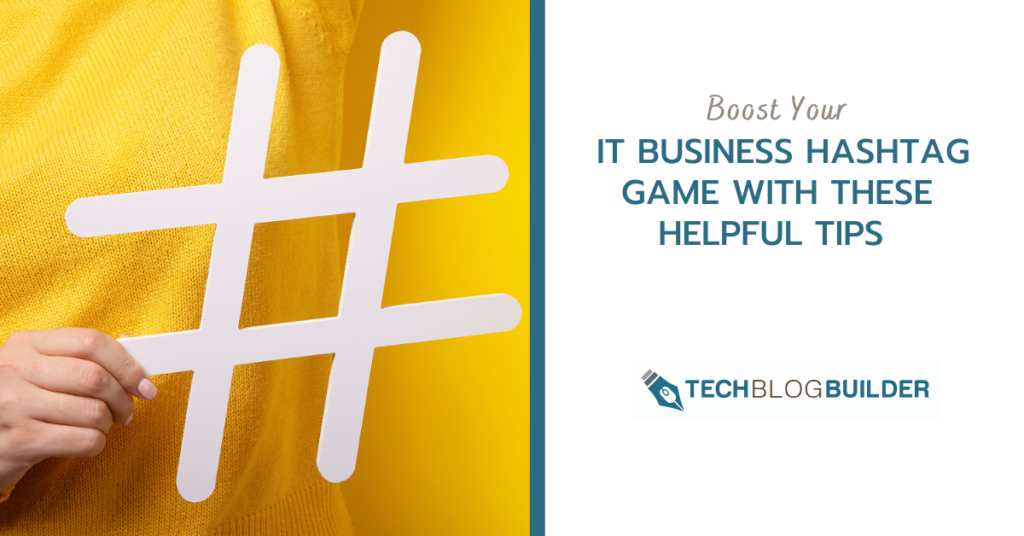When sharing your marketing content on various social media platforms, you can significantly increase your chance of having it seen by using the right hashtags.
Hashtags are simply the keywords of social media. They are designated by a “#” in front of the key term you think people will be using to find the types of products, services, and topics in your social posts.
IT business owners often miss out on connecting with their target audience on social media simply because they don’t know how to use hashtags properly. Below, we’ll give you the best practices and tips that will boost your hashtag game and get you noticed!
Are Hashtags THAT Important?
If you post your social content without the use of hashtags, is it really going to make much of a difference?
Yes, if you care about connecting with more followers on platforms like LinkedIn, Twitter, Facebook, and Instagram. Hashtags are the way that people search out things of interest within a sea of social posts that never stop coming.
If you want to know what’s up at the Golden Globes, then you might search “#GoldenGlobes” on Twitter. If you’re a sportscar enthusiast, then you can follow the hashtag “#lovesportscars” on Instagram to get cool car stuff in your feed.
If you aren’t using the right hashtags on your posts, or any hashtags at all, your posts won’t get nearly as much traction. It’s kind of like putting up your website but never doing any search engine optimization with keywords. Your content is out there, but is anyone seeing it?
Here’s an example of what paying attention to hashtags can do for your marketing:
- Tweets that have a hashtag get between 50% to 100% more engagement than those that don’t.
- Tweets with 1-2 hashtags have a 55% better chance of being shared by retweet.
- On Instagram, posts with at least 1 hashtag get 29% more interactions and posts with 11+ hashtags get 79.5% more.
Tips for Using Hashtags Like a Pro
Know the Difference Between Hashtag Types
There is more than one type of hashtag, so when you’re putting together a strategy for using hashtags to boost content marketing visibility, you want to know what these are.
Here is rundown on the three main types of hashtags.
Search Hashtag
A search hashtag would be like a keyword that you use for SEO. You’re choosing it to help your social posts and content be more easily found. Part of finding a great search hashtag is looking at what hashtags people are already following that would relate to IT business products and services.
Some potential MSP business search hashtags would be:
#Cybersecurity
#ComputerTips
#BusinessProductivity
Trending Hashtag
Trending hashtags are like the “flash mob” of Twitter. If something is big news, people start using that hashtag to join the conversation. These are usually hot for a while and then cool off as the event subsides.
Examples would be:
#Oscars2020
#WandaVisionFinale
#RobinhoodTraders
Brand Hashtag
Brand hashtags are useful to help your own followers find your social content. If you begin adding #MikesComputers to all your social posts, it’s like putting a social media tracker on them that can be easily searched. You can also help build brand loyalty and encourage your customers to post using your hashtag.
However, you want to use brand hashtags sparingly because they won’t typically help you be found by new potential customers, as people that don’t know you won’t know to search your name.
Perform Hashtag Research
Many IT business owners will just come up with hashtags off the top of their head without doing any research to see how many people actually search on that keyword.
Not doing hashtag research can cause you to miss opportunities to have your social posts seen by more people.
For example, say you use #networkconnectivity on one of your LinkedIn posts about your network services. It looks like a perfectly fine keyword, right?
But if you did a little research, you would see that currently only 39 people on LinkedIn are following that hashtag (which means they see it in their feed).
On the other hand, #networkinfrastructure has 1,229 people following it.
That’s a potential increase in people that might see your post and contact you for services of 1,190. So, it pays to do your hashtag research!
Two easy & free places to research and find good hashtags to use are:
- LinkedIn: Search a hashtag in the top Search box and click on the hashtag result to see the follower count.
- Instagram: Begin typing a hashtag in the top Search box and you’ll get a listing of hashtag results and how many posts use that hashtag (indicating how popular they are).

You can also find good search hashtags using several web tools out there, some paid and some free. A few of these are:
Know How Many Hashtags to Use for Each Social Platform
How many hashtags should you use on your posts? The answer is: It depends where your post is going.
For example, Instagram users LOVE hashtags, and they have a “the more, the merrier” attitude. Facebook users on the other hand get turned off if you use more than just 1 or 2 hashtags on a post.
If you want to make the biggest impact, you need to know how many hashtags to use per the social platform you’re posting on.
According to SocialPilot (and backed up by other online resources) here is a good rule of thumb for how many hashtags to use per each platform:
- Twitter: Use no more than 2 hashtags
- Facebook: Use 2 hashtags
- Instagram: Using 11 hashtags gets the highest engagement numbers
- LinkedIn: Use no more than 5 hashtags
Hop on Relevant Trending Hashtags
A lot of brands will watch trending hashtags on Twitter and hop on those to get eyes on their brand and message. While this can be hit or miss, it can get thousands, or sometimes millions, of eyes on your Twitter post if you do it right.
Some trending hashtags come around once and are hot for a day or three and then they’re gone, such as the #BernieMittens meme that everyone was having a blast with in January. Here’s an example of a company trying to join in the fun.

Other trending hashtags you can do more planning for, since they tend to come around regularly, such as #Friyay (every Friday) or #TalkLikeAPirateDay (every September 19th).
Some weekly hashtags that you can plan some posts for include:
#MondayMotivation
#ThrowbackThursday
#FridayFeeling
Add in Local Names Where It Makes Sense
Local IT businesses can be found more easily when they use the name of their city or area in keywords and hashtags. For example, in addition to #VirusRemoval try #VirusRemovalAtlanta.
Just be sure to also keep the main hashtag included for more reach. If you only use hashtags with your city name included, you might find that no one is really following them and you’ll lose an opportunity to gain more visibility.
Shorter is Better
Long hashtags are not as easy to read and don’t generally have as many posts or followers. It’s better to keep hashtags short and sweet. This is especially true on Twitter when you have limited characters to use and hashtags are included in your character count.
The only exception would be if you’re jumping on a trending hashtag, because those are already set by the masses, so in that case you’re just using the one that everyone else has already decided on.
There are No Spaces or Punctuation in Hashtags
If you’re not familiar with hashtags, then you may not realize that they do not have any spaces between the words. If you add a space or punctuation in a hashtag, then anything after that will not be picked up in the tag.
You can help make hashtags easier to read without spaces between the words by using capitals if you like. For example:
- Instead of #becybersafe
- Use #BeCyberSafe
Put Hashtags At the End of Your Message
Hashtags are best when put at the end of your post, so they don’t get in the way of your main message. You may even want to add a couple of line breaks from the last line of your post before the hashtags.
This keeps them from getting annoying to the reader. It’s also a place where users natively expect hashtags to be.
Follow Hashtags Relevant to Your Business
You can get some great hashtag ideas by following hashtags on Instagram, Twitter, or LinkedIn. Companies often use more than one associated hashtag when posting, so just following a main hashtag like #BusinessProductivity, can bring up posts using associated hashtags that you can also incorporate into your posts.
For example, I found this Twitter post below by searching #BusinessProductivity, and there are two other great potential MSP hashtags to use there: #ProductiveTeam and #BusinessEfficiency.

By seeing how other businesses are using hashtags, you can get some great ideas for your own social posts. (Although don’t do exactly what that guy did, he used too many for Twitter, which is 2 hashtags max. 😉)
Rev Up Your Social Media Strategy with Hashtags!
Taking the time to choose the right hashtags and monitor those that are trending can help you boost your social media strategy and earn more followers and leads.
Do you have a brand hashtag that you use on your social posts? Share it in the comments!


